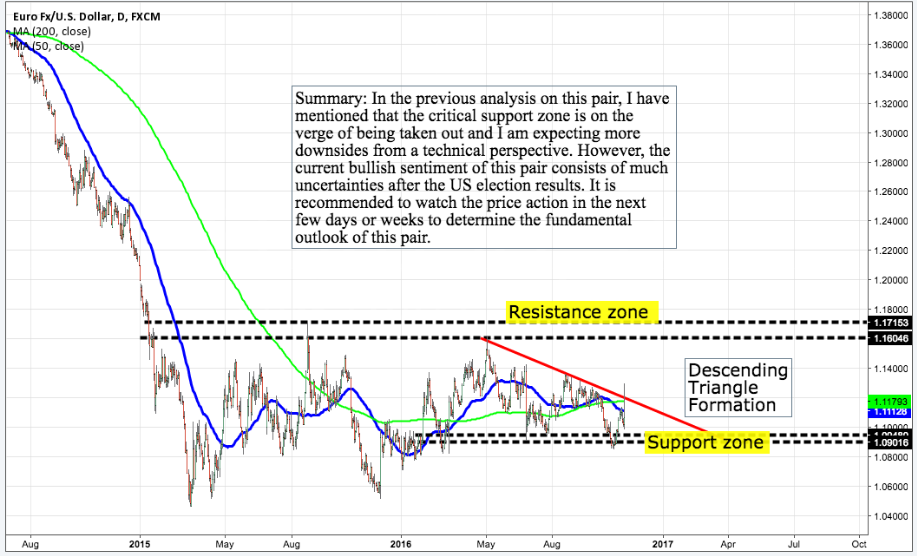Fundamental Outlook: EUR/USD
Over the Asia-Pacific session, the market's focus has remained firmly fixed on the US Presidential Election with a Donald Trump victory looking all but certain along with Republicans retaining the House of Representatives and gaining the Senate. Consequently, USD has weakened across the board along with strength in safe-haven currencies given a strong risk-off tone across financial markets. There is no tier 1 data due to be announced during today's London session with focus likely to remain on the outcome of the Presidential Election.
In today’s session, we expect the strongest currency to be EUR which can have a tendency to appreciate during risk-off environments. Furthermore, with the SNB's tendency to intervene with CHF and BoJ's recent comments stating their willingness to intervene in JPY, we see EUR as the next alternative although both CHF and JPY will likely remain supported from safe-haven flows. The weakest currency is expected to be USD as a victory for Donald Trump is considered to be USD negative. Furthermore, December rate hike expectations have now declined to 50%.
Source: Jarratt Davis
Technical Outlook: EUR/USD

Overview of Currencies
USD: The Federal Reserve are most likely to hike rates at their next meeting as Fed rhetoric over recent months has continued to suggest a December hike is highly likely which continues to support September's FOMC Economic Projections where 14 of 17 Fed members expected a hike in 2016. This gives the USD currency an overall bullish tone heading into the Fed's December meeting.
EUR: The ECB are most likely to leave their policy unchanged at their next meeting because they have already cut their main rates heavily over recent years and they are at what many experts consider to be an ultimate low. If the bank did conduct a policy change within the next three months, then the most likely move is an increase in its QE programme because it is still battling low inflation alongside low interest rates, so more powerful action could be needed. This gives the EUR currency an overall bearish bias over the next three months.
GBP: The BoE are most likely to leave policy unchanged over the next three months as upward revisions to growth and inflation expectations amongst surprisingly upbeat UK data has reduced the need for further easing. Although the UK economy has continued to show resilience following the UK voting to leave the EU, there is still a high degree of uncertainty, especially surrounding exit negotiations which will begin once Article 50 is triggered. Therefore although the BoE are likely on hold for the time being, further easing is still a distinct possibility. For this reason, we continue to view GBP as fundamentally bearish.
AUD: The RBA are most likely to leave policy unchanged at their next meeting, however, until we start to see any notable pickup in inflation, further easing remains a distinct possibility. Continued AUD appreciation is also noted as a concern for the RBA and likely provides an additional argument for further cuts. Nevertheless, market consensus is currently for the RBA to remain on hold at least for the rest of 2016. For these reasons we currently hold a neutral bias for AUD.
NZD: There is a strong possibility that the RBNZ could ease policy further at their November meeting due to continued concerns over inflation. Despite Q3 inflation beating expectations at 0.2% q/q and y/y, the RBNZ are still expected to ease at their November meeting with OIS pricing suggesting an 84% chance of a 25 basis point cut. With continued expectations for further RBNZ easing, we maintain a bearish bias on NZD.
CAD: The BoC are most likely to leave monetary policy unchanged at their next meeting as Canadian inflation is within the BoC’s target range of 1-3% with the economy also supported by accommodative fiscal measures. If the BoC did conduct a policy change within the next three months, it would likely be a rate cut based on concerns over Canada’s competitiveness since CAD’s appreciation throughout the year and increasing concerns over inflation. Although this gives CAD a slightly bearish fundamental bias, with most central banks currently in easing cycles CAD has a comparatively neutral bias.
JPY: The BoJ will most likely need to ease policy further in the future as inflation in Japan continues to decline with little indication that it will eventually reach the BoJ's target of 2%. At their November meeting, however, the BoJ expressed concerns over the impact of low interest rates on financial system stability and therefore the BoJ may be more reluctant to increase easing until absolutely necessary. For this reason, we continue to hold our overall bearish fundamental bias, however, acknowledge that further declines in inflation may be necessary before further easing can be expected.
CHF: The SNB are most likely to leave their policy unchanged at their next meeting, as interest rates in Switzerland already remain at a record low of -0.75%. If the SNB were to change policy in the next three months, it would likely be a rate cut as inflation continues to remain far below the SNB’s target. This gives CHF an overall bearish tone.
Source: Jarratt Davis